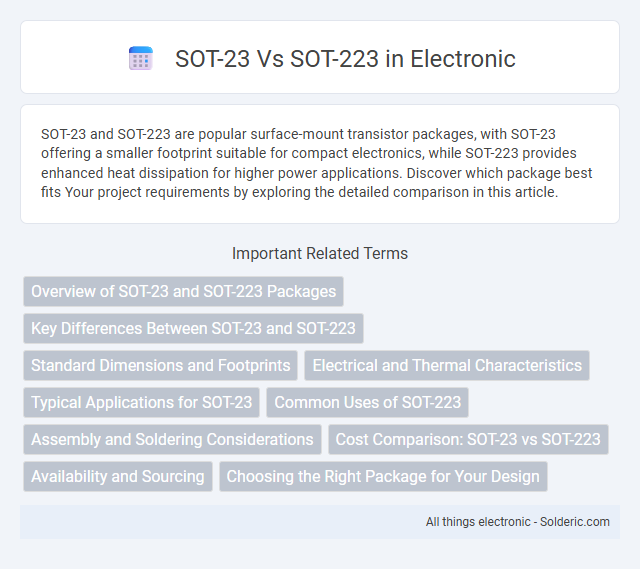SOT-23 and SOT-223 are popular surface-mount transistor packages, with SOT-23 offering a smaller footprint suitable for compact electronics, while SOT-223 provides enhanced heat dissipation for higher power applications. Discover which package best fits Your project requirements by exploring the detailed comparison in this article.
Comparison Table
| Feature | SOT-23 | SOT-223 |
|---|---|---|
| Package Type | Small Outline Transistor, 3-lead | Small Outline Transistor, 4-lead |
| Dimensions | 2.9mm x 1.3mm | 6.7mm x 3.7mm |
| Thermal Resistance (Junction to Ambient) | Approx. 250 degC/W | Approx. 60 degC/W |
| Power Dissipation | Up to 350mW | Up to 1W or higher (with heatsink) |
| Application | Low-power transistors, small ICs | Power transistors, voltage regulators |
| Mounting | Surface mount | Surface mount with enhanced heat dissipation |
Overview of SOT-23 and SOT-223 Packages
SOT-23 and SOT-223 are popular surface-mount transistor packages widely used in electronic circuits for their compact size and thermal efficiency. SOT-23 features a small, three-lead outline measuring approximately 2.9mm by 1.3mm, optimized for space-constrained applications and low-power devices. SOT-223 is larger, with a four-lead design typically around 6.7mm by 3.7mm, providing enhanced power dissipation and thermal management suitable for higher-power components.
Key Differences Between SOT-23 and SOT-223
SOT-23 and SOT-223 differ primarily in size, power dissipation, and pin count, with SOT-23 being a small, three-pin package suitable for low-power applications, while SOT-223 offers larger dimensions, better heat dissipation, and up to four pins, making it ideal for medium-power devices. SOT-223's larger thermal pad improves heat transfer, supporting higher current loads compared to the compact SOT-23. When selecting a package for Your circuit, consider these differences to ensure optimal performance and thermal management.
Standard Dimensions and Footprints
SOT-23 packages typically measure around 2.9mm x 1.3mm with a three-lead footprint suitable for compact circuit designs, while SOT-223 packages are larger, approximately 6.7mm x 3.7mm, featuring a four-lead footprint designed for better heat dissipation. The SOT-23 footprint's minimal size is ideal for space-constrained applications, whereas the SOT-223's footprint accommodates higher power components by providing enhanced thermal performance. Circuit board layout considerations must match these standardized footprints to ensure proper component placement and soldering reliability.
Electrical and Thermal Characteristics
SOT-23 packages typically handle lower power dissipation and have higher thermal resistance compared to SOT-223, which is designed for higher power applications with better heat dissipation capabilities. SOT-223's larger surface area and thermal pad enable more efficient heat transfer, reducing junction temperature and improving reliability in high-current scenarios. Choosing the right package impacts your circuit's thermal management and electrical performance, especially under demanding operating conditions.
Typical Applications for SOT-23
SOT-23 packages are commonly used in low-power, high-density electronic circuits such as signal processing, voltage regulation, and switching applications due to their compact size and efficient thermal performance. This package is ideal for surface-mount transistors, diodes, and small integrated circuits in portable devices and consumer electronics. The small footprint of SOT-23 enables designers to optimize PCB space while maintaining reliable electrical performance.
Common Uses of SOT-223
SOT-223 packages are commonly used in power regulators, voltage regulators, and low-dropout (LDO) regulators due to their ability to handle higher power dissipation compared to SOT-23 packages. You will often find SOT-223 in applications requiring efficient heat dissipation and higher current capacity, such as power management circuits and audio amplifiers. Its larger size and enhanced thermal performance make it ideal for devices where thermal management is critical.
Assembly and Soldering Considerations
SOT-23 packages, being small and compact, require precise placement and careful thermal management during assembly to prevent damage from excessive heat exposure. SOT-223 components, larger with heatsinking tabs, offer easier handling and improved heat dissipation, allowing for more robust soldering processes and enhanced thermal performance on your PCB. Proper soldering techniques tailored to each package type ensure reliable electrical connections and optimal device longevity in your electronic assemblies.
Cost Comparison: SOT-23 vs SOT-223
SOT-23 packages typically have lower manufacturing costs due to their smaller size and reduced material usage compared to SOT-223. SOT-223, offering better thermal performance and higher power dissipation, often results in a higher price point reflecting its enhanced capabilities. Cost considerations between SOT-23 and SOT-223 depend largely on application requirements, balancing budget constraints against performance needs.
Availability and Sourcing
SOT-23 packages offer widespread availability due to their extensive use in small-signal transistors and integrated circuits, making them easily sourced from various electronic component distributors worldwide. SOT-223 components are less common but preferred for applications requiring higher power dissipation, available through specialized suppliers and OEM channels. Your choice between SOT-23 and SOT-223 will depend on the balance between sourcing convenience and specific power handling requirements.
Choosing the Right Package for Your Design
SOT-23 packages are ideal for compact designs requiring minimal PCB space and low power dissipation, commonly used in signal-level components like transistors and diodes. In contrast, SOT-223 packages offer better thermal performance and higher power handling, making them suitable for voltage regulators and power transistors in medium-power applications. Selecting between SOT-23 and SOT-223 depends on your design's thermal requirements, available board area, and power dissipation needs.
SOT-23 vs SOT-223 Infographic

 solderic.com
solderic.com